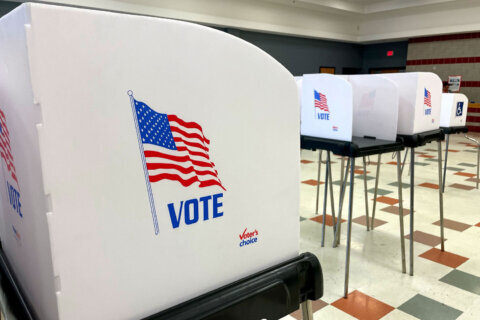This article was republished with permission from WTOP’s news partners at Maryland Matters. Sign up for Maryland Matters’ free email subscription today.
This content was republished with permission from WTOP’s news partners at Maryland Matters. Sign up for Maryland Matters’ free email subscription today.
A decade after Maryland lawmakers first affirmed their support for bringing offshore wind energy to federal waters off the coast of Ocean City — and before a single wind turbine has gone into the water here — the General Assembly on Monday gave its final approval to a bill designed to expand the state’s offshore wind energy footprint even more.
The measure crossed its final hurdles on Monday afternoon, when the House passed the Senate version of the bill by a vote of 101-38, and the Senate passed the House version late in the evening, 36-10, sending the legislation to Gov. Wes More’s desk. Moore (D), who has embraced the wind energy industry as a way to create hundreds of high-paying jobs and help combat climate change, has promised to sign it.
The Promoting Offshore Wind Energy Resources (POWER) Act, sponsored by Del. Lorig Charkoudian (D-Montgomery) in the House and by Sens. Katie Fry Hester (D-Howard) and Brian J. Feldman (D-Montgomery) in the upper chamber, attracted support from a potent combination of labor unions, business interests and environmentalists — and received modest Republican support in each house. Sen. Johnny Ray Salling (R) and Del. Ric Metzgar (R) each represent the area of Baltimore County where wind turbines are expected to be built and assembled, at the Tradepoint Atlantic industrial development. Sen. William G. Folden (R-Frederick) also voted for the measure Monday night.
“The POWER Act is meeting the moment,” Hester said. “Our state has set ambitious climate goals, and now we are meeting them by prioritizing the rapid deployment of generation and transmission technologies to leverage over $1.5 billion of investment from the private sector.”
While two offshore wind developers, Ørsted and US Wind, wait for final federal government approval to proceed with their projects near Ocean City and have begun to assemble production and maintenance facilities and workforces across the region, the POWER Act commits the state to even more offshore energy generation and attempts to make it easier to connect the wind power to the regional electric grid on land.
Jeff Grybowski, the US Wind CEO, called the legislation “a real game changer for Maryland.”
“It sets a path for the people of Maryland to reap the benefits of huge amounts of clean energy in the coming years,” he said. “It also tells the entire offshore wind industry globally that Maryland is back big time as a major player.”
The bill will:
- Set a goal for the state to generate 8.5 gigawatts of offshore wind by 2031. Maryland is currently building 2 gigawatts
- Strengthen labor standards for offshore wind manufacturing, installation and maintenance, increasing the likelihood that contractors will use union
- Procure roughly 1 additional gigawatt of offshore wind power in existing lease areas
- Help to facilitate the construction of a shared transmission infrastructure for all the offshore wind projects to reduce the cost and environmental impact
US Wind and Ørsted have yet to find suitable landing spots onshore for their power generation, and have been looking primarily in Delaware. It’s unclear how and where the shared transmission infrastructure that the bill envisions would be set up.
The bill has been modeled in part after a recent New Jersey law, which addresses ways to maximize the state’s ability to connect the electricity generated at sea to the electric grid.
Even with the broad coalition of organizations supporting the bill, several Republicans in the House and Senate have offered vocal opposition. During the penultimate debate on the legislation on the Senate floor Monday evening, Sen. Mary Beth Carozza (R-Lower Shore), who represents Ocean City, continued to ask pointed questions about the project, reflecting the opposition of tourism and real estate interests in the resort town that fret the wind towers will ruin the view from the shoreline.
Other Republicans in the legislature have echoed the complaints of U.S. Rep. Andy Harris (R-1st) and some of his GOP colleagues, who say the testing for the wind installations are already responsible for whale deaths and that the turbines themselves will kill countless birds. Federal officials have largely debunked those statements.
Currently, there are only seven wind turbines in U.S. waters — five near Block Island in Rhode Island and two off the coast of Virginia Beach. But the Biden administration has made expanding offshore wind a top priority, and several Northeastern and Mid-Atlantic states are scrambling to install as many as they can as quickly as they can. Ørsted and US Wind hope to have their first turbines spinning off the coast of Maryland in late 2025 or early 2026.







